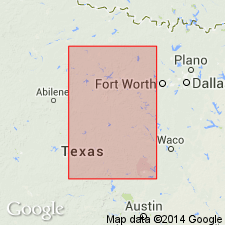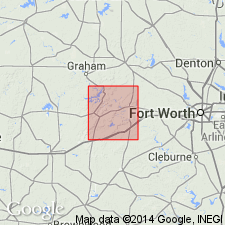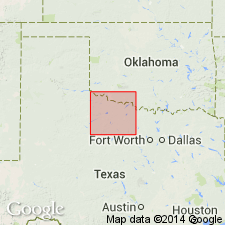
- Usage in publication:
-
- Gonzales Creek member
- Modifications:
-
- Original reference
- Dominant lithology:
-
- Shale
- Sandstone
- Clay
- Limestone
- Coal
- AAPG geologic province:
-
- Bend arch
Summary:
Pg. 24, 31; Univ. Texas Bull., no. 2132, p. 127-134. Gonzales Creek member of Graham formation. In southeastern Young County, Brazos River region, central northern Texas, 230+/- feet of shale and sandstone occur above Jacksboro limestone. This portion of Graham formation of Brazos River Valley is named Gonzales Creek member, for a creek in Eastland County [?]. Where Jacksboro limestone is absent the Gonzales Creek member rests on underlying Finis shale. It underlies Bunger limestone member of Graham formation, and is composed of poorly bedded, lenticular dark-brown sandstones, sandy shales, red clays, gypsiferous black clays, 2 limestone lentils, and a coal bed. The sandstones are lenticular and the shales are variable. One limestone lentil occurs 30 feet below Bunger limestone and the other 80 feet below the Bunger. [Age is Pennsyvlanian.]
Named from Gonzales Creek [now Gunsolus Creek, located in Stephens and Eastland Cos.], Brazos River region, central northern TX (additional locality information from USGS GNIS database, accessed April 23, 2012).
Source: US geologic names lexicon (USGS Bull. 896, p. 836).

- Usage in publication:
-
- [Gonzales Creek member]
- Modifications:
-
- Not used
- AAPG geologic province:
-
- Fort Worth syncline
Summary:
Pg. 112. Stated that Home Creek limestone of Jack County, Texas, includes Jacksboro limestone.
Source: US geologic names lexicon (USGS Bull. 896, p. 836).

- Usage in publication:
-
- Gonzales Creek shale member
- Modifications:
-
- Areal extent
- AAPG geologic province:
-
- Bend arch
Summary:
Pg. 61-63. Divided the lower 125 feet of Graham formation that is present in Palo Pinto County, Brazos River region, central northern Texas, into the following members (descending): Bunger limestone, 6 feet; Gonzales Creek shale, 116 feet; Eastland sandstone (new name), 10 to 15 feet; and Finis shale, 50 feet. [Age is Pennsylvanian.]
Source: US geologic names lexicon (USGS Bull. 896, p. 836).

- Usage in publication:
-
- Gonzales Creek Member
- Modifications:
-
- Areal extent
- AAPG geologic province:
-
- Bend arch
- Fort Worth syncline
Summary:
Mapped as a unit in Thrifty and Graham Formations (undivided) of Cisco Group in the southeastern part of the mapped area. Present in southwestern Young Co, TX on Bend arch, northeastward to south of Maryetta, Jack Co, TX on Fort Worth syncline. Consists of sandstone, fine to medium grained, thin bedded to massive, soft-sediment deformation common, sheet sandstones in upper part, lenses and channel-fill bodies of chert-pebble conglomerate locally near base; interbedded silty and sandy shale and mudstone with rare carbonaceous lenses; locally channels out Gonzales Limestone; forms prominent escarpment and broad dip slope. Thickness 10-50 ft, thinning northeastward. Of Virgil age (Late Pennsylvanian). Geologic map.
Source: GNU records (USGS DDS-6; Denver GNULEX).
For more information, please contact Nancy Stamm, Geologic Names Committee Secretary.
Asterisk (*) indicates published by U.S. Geological Survey authors.
"No current usage" (†) implies that a name has been abandoned or has fallen into disuse. Former usage and, if known, replacement name given in parentheses ( ).
Slash (/) indicates name conflicts with nomenclatural guidelines (CSN, 1933; ACSN, 1961, 1970; NACSN, 1983, 2005, 2021). May be explained within brackets ([ ]).

